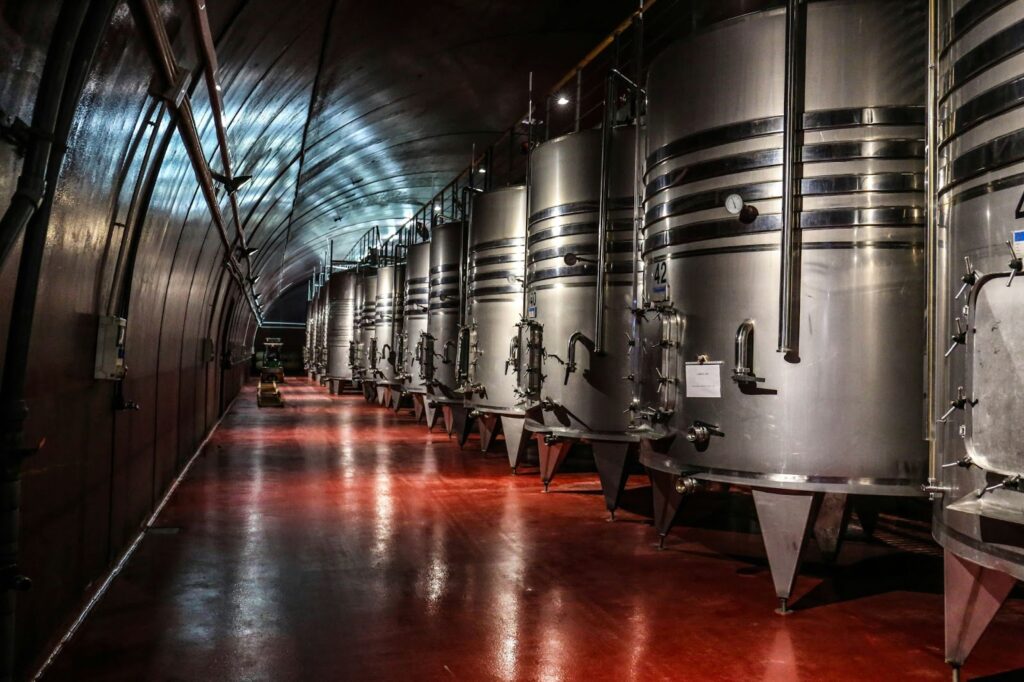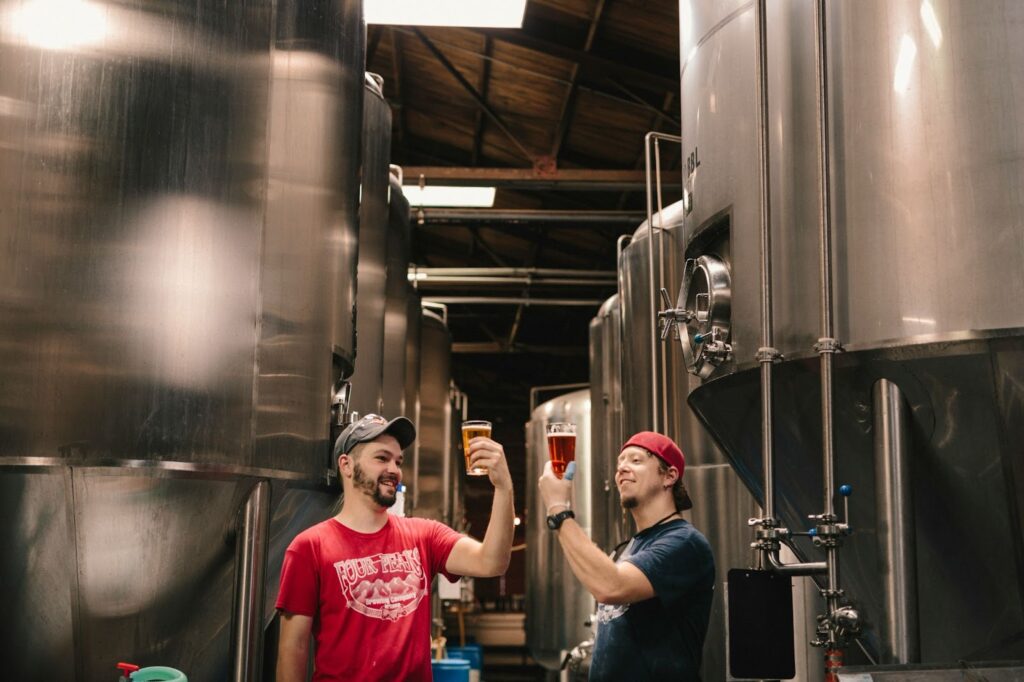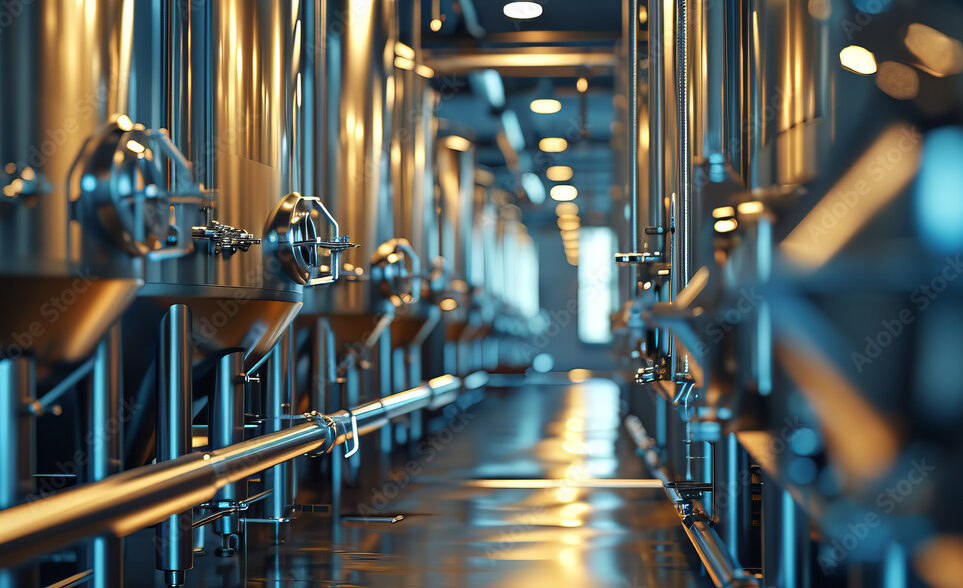Crafting the perfect space for a brewery building requires careful planning and attention to design detail. Whether you are starting a small craft brewery or expanding an existing operation, creating a functional and efficient space is essential to success.
In 2022, small and independent brewers collectively produced 24.3 million barrels of beer, maintaining the production level of 2021. The market share of craft beer by volume grew slightly to 13.2% from 13.1% the previous year.
So, If you are considering setting up a brewery building, this article will provide you with the things you need to know.
We will explore the basics of brewery building, including the importance of space, key elements to consider, and how to navigate regulations. We will also discuss the process of planning and designing your brewery space, as well as choosing the right equipment.
Table of Contents:
- Understanding the Basics of Brewery Building
- Planning Your Brewery Space
- Designing Your Brewery Building
- Choosing the Right Equipment for Your Brewery
- Navigating Brewery Building Regulations
- Conclusion
- Frequently Asked Questions

Understanding the Basics of Brewery Building
A successful brewery begins with a solid foundation, both literally and figuratively. Understanding the basics of brewery building is crucial to creating a space that meets your needs and goals. One of the key factors to consider is the importance of space.
The Importance of Space in Brewery Building
Space is a valuable asset in a brewery. It not only affects the production process but also impacts the overall efficiency and workflow.
Sufficient space allows for proper equipment placement, ease of movement, and optimal utilization of resources. It also enables you to comply with health and safety regulations and provides room for expansion in the future.
Imagine walking into a brewery where every corner is cramped, and equipment is haphazardly placed. It would be a nightmare for the brewers and staff to navigate through the chaos, hindering their ability to produce quality beer.
On the other hand, a well-designed and spacious brewery allows for a smooth workflow, ensuring that every step of the brewing process is executed with precision and care.
Furthermore, having ample space in your brewery provides room for growth and expansion. As your business flourishes and demand for your beer increases, you will need to scale up your production.
With sufficient space, you can easily add new equipment, storage tanks, and fermentation vessels without disrupting the existing operations. This flexibility is essential for adapting to market demands and staying competitive in the brewing industry.
Check out: Expert Brewery Construction Tips
Key Elements of a Brewery Building
When designing your brewery building, several key elements should be taken into account. These include:
Layout and flow
Carefully consider the flow of ingredients, equipment, and personnel throughout the space. A well-designed layout can minimize bottlenecks and streamline production. Think about the logical progression of the brewing process, from milling the grains to packaging the final product. By optimizing the layout, you can create a seamless workflow that maximizes efficiency and reduces unnecessary steps.
Utilities and infrastructure
Ensure that your brewery has access to the necessary utilities, such as water, electricity, and ventilation. Plumbing and drainage systems should also be designed to handle the demands of brewery operations. Adequate water supply is crucial for brewing, as it is used in various stages, including mashing, lautering, and cooling. Additionally, reliable electricity and proper ventilation are essential for powering and maintaining the brewing equipment, as well as creating a comfortable working environment for your staff.
Temperature control
Maintaining proper temperature is crucial for the brewing process. Insulation, HVAC systems, and refrigeration units should be incorporated into the design to ensure consistent and controlled temperatures. Different styles of beer require specific temperature ranges for fermentation and conditioning. By investing in temperature control systems, you can create an optimal environment for yeast activity, resulting in the desired flavors and aromas in your beer.
Check out: Cooling Solutions For Metal Buildings
Safety features
Implement safety measures such as fire suppression systems, emergency exits, and adequate lighting to protect your staff and equipment. Brewing involves working with flammable materials, such as alcohol and cleaning agents, making fire safety a top priority. Installing fire suppression systems, such as sprinklers and fire extinguishers, can help prevent and minimize damage in case of a fire. Additionally, well-lit spaces and marked emergency exits ensure that your staff can navigate the brewery safely, reducing the risk of accidents.
By considering these key elements in your brewery building design, you can create a space that not only meets your current needs but also sets the foundation for future growth and success. Remember, a well-designed brewery is not just a place to make beer; it is a space where creativity, craftsmanship, and passion come together to create liquid art.
Planning Your Brewery Space
Before diving into the design process, it is important to assess your needs and goals for your brewery space. This will help you make informed decisions and create a space that aligns with your business objectives.
When considering the layout of your brewery space, it’s essential to think about the overall ambiance and customer experience. Creating a welcoming and visually appealing environment can enhance the overall brewery visit for customers.
Factors such as seating arrangements, lighting, and decor should be taken into account to ensure a comfortable and enjoyable atmosphere.
Assessing Your Needs and Goals
Determine the size of your operation, production capacity, and future expansion plans. Consider factors such as the types of beer you will produce, packaging requirements, and potential growth projections.
Assessing your needs and goals will guide you in determining the appropriate space requirements and equipment selection.
Additionally, it’s crucial to consider sustainability practices in your brewery space design. Implementing eco-friendly initiatives such as energy-efficient lighting, water conservation measures, and waste recycling programs can not only reduce your environmental impact but also appeal to environmentally conscious consumers.
Space Planning Considerations for Breweries
When planning your brewery space, there are several considerations to keep in mind:
- Zoning and building codes: Familiarize yourself with local zoning and building codes to ensure compliance. This includes restrictions on noise, waste disposal, and operating hours.
- Workflow optimization: Plan the layout of your brewery to minimize the distance traveled between different stages of the brewing process. This can improve efficiency and reduce labor requirements.
- Flexibility and scalability: Design your brewery space with flexibility in mind. Allow for future expansion and the ability to adapt to changing market demands.

Designing Your Brewery Building
Designing your brewery building is an exciting phase that allows you to bring your vision to life. It involves creating a space that not only functions efficiently but also reflects your brand and aesthetic preferences.
Before diving into the design process, it’s essential to consider the layout of the building, taking into account factors such as natural light, ventilation, and accessibility. These elements can greatly impact the overall functionality and atmosphere of your brewery.
When designing the exterior of your brewery building, think about curb appeal and how it will attract customers. Consider elements such as signage, outdoor seating areas, and landscaping to create an inviting and welcoming facade. The exterior design sets the tone for the brewery experience and can help differentiate your brand from competitors.
Check out: How To Create Your Perfect Custom Steel Building Design
Essential Features of Brewery Design
When considering the design of your brewery, there are several essential features to incorporate:
- Tasting room: If you plan to have a dedicated tasting room, ensure it is inviting and comfortable for visitors. Consider factors such as seating areas, bar design, and ambiance.
- Production area: The production area should be designed with the optimal workflow in mind. Arrange equipment strategically to minimize the time and effort required for production tasks.
- Storage space: Allocate sufficient space for raw ingredients, packaging materials, and finished products. Ensure proper organization and accessibility to minimize waste and avoid contamination.
Incorporating Functionality and Aesthetics
While functionality is key, aesthetics should not be overlooked. Incorporate your brand identity into the design by choosing materials, colors, and finishes that align with your vision.
Create a space that is visually appealing and reflects the unique qualities of your brewery. Consider incorporating elements such as custom lighting fixtures, artwork, and branded signage to enhance the overall aesthetic appeal of the space.
Choosing the Right Equipment for Your Brewery
Selecting the right equipment is crucial for the success of your brewery. Quality equipment can improve efficiency, enhance product quality, and maximize the use of your available space.
When setting up a brewery, it’s important to consider not only the current needs but also future growth projections. Investing in scalable equipment that can accommodate increased production volumes as your brewery expands can save you time and money in the long run. Additionally, think about the flexibility of the equipment—can it adapt to different brewing styles or recipes?
Equipment Selection Guide for Breweries
When choosing equipment for your brewery, consider the following:
- Capacity: Determine the production capacity you require and choose equipment that can handle it efficiently.
- Quality and reliability: Invest in high-quality equipment that is built to last. Consider factors such as durability, ease of maintenance, and manufacturer reputation.
- Space optimization: Opt for equipment that is specifically designed for compact spaces. This will allow you to maximize your available space without compromising functionality.
Another crucial factor to consider is energy efficiency. Look for equipment that is designed to minimize energy consumption, such as insulated brewing vessels or systems with heat recovery capabilities. Not only will this help reduce your brewery’s environmental impact, but it can also lead to cost savings in the long term.
Check out: Effective Strategies For Insulating Steel Buildings
Maximizing Space with the Right Equipment
Efficient use of space is essential in a brewery. Consider equipment options that combine multiple functions or have a small footprint. Compact systems such as modular brewhouses and space-saving fermentation vessels can help maximize your production capacity while minimizing space requirements.
Furthermore, think about the layout of your brewery and how different pieces of equipment will flow together in the production process. A well-thought-out equipment arrangement can streamline operations, reduce bottlenecks, and improve overall productivity.
Don’t forget to factor in space for future expansions or additional equipment upgrades as your brewery grows.
Pro tip:
Steel buildings support clearspan construction, a distinctive feature that allows the creation of spaces over 350 feet wide without any column support. If support columns are incorporated in the center of the building (known as multiple spans), they can be extended out on either side for a building over 500 feet in width.
Navigating Brewery Building Regulations
Understanding and complying with brewery building regulations is crucial to ensure the legality and safety of your operation.
Understanding Local Zoning and Building Codes
Research and understand the specific zoning and building codes that apply to breweries in your area. This includes regulations regarding operating hours, noise levels, waste management, and parking requirements. It is important to obtain the necessary permits and licenses to avoid legal issues down the line.
Generally, breweries are categorized under Commercial or Industrial zoning. These classifications permit business and industrial activities, such as manufacturing and the sale of goods and services. Breweries are often allowed as a primary use in these zones, but special permits or conditions may apply.
Health and Safety Regulations for Breweries
Breweries are subject to health and safety regulations to protect both employees and consumers. This includes proper handling and storage of ingredients, adherence to sanitation practices, and compliance with occupational health and safety standards.
Implementing a comprehensive safety program and providing training to your staff is essential to maintain a safe and healthy work environment.

Conclusion
Crafting the perfect space for brewery building involves understanding the basics, planning and designing with intention, choosing the right equipment, and ensuring compliance with regulations.
By carefully considering each element and making informed decisions, you can create a brewery space that is not only functional and efficient but also a reflection of your brand.
Since 2001, SteelCo is a leading PEMB materials provider dropshipping high-quality building materials across the US, and also offering commercial construction services in Georgia for a wide range of building and client industry types.
On the PEMB side, we assist our clients in navigating local building codes and construction timelines, providing basic conceptual designs and stamped engineering plans to simplify the process of obtaining necessary permits and licenses.
Learn more about our expertise in PEMB commercial buildings and how we can assist you in your brewery building project.
———————————–
Frequently Asked Questions
What insulation is best for a brewery building?
Insulating a brewery building is crucial for maintaining a stable temperature, which is essential for the brewing process. Insulated Concrete Form (ICF) blocks are considered one of the best materials for brewery construction. These blocks are made from a mix of concrete and foam insulation, providing excellent thermal efficiency and energy savings.
Is Steel a good choice for brewery buildings?
Steel clear span buildings are an excellent choice as they offer wide open interior spaces without any separation. Clear span designs enhance safety, allow for quick and efficient processing, and provide ample room for brewing equipment and storage.
Which state is best to start a brewery business?
Vermont, Maine, Colorado, and Oregon are excellent options because of their strong craft beer cultures and favorable business environments. However, it’s crucial to consider local demand, competition, and specific business needs before deciding.
How much do I need to build a brewery?
The cost of establishing a brewery is subject to a wide range of variables, including the brewery’s scale, geographical setting, and the specific brewery model you aim to launch. Generally, initial expenses can span from $250,000 to $1 million for a microbrewery. In contrast, a standard-sized brewery may cost around $500,000 to $1.5 million. These estimates include the outlay for equipment, licensing, initial marketing, and other foundational costs, and they serve as a broad guide to the potential financial commitment involved in starting a brewery.
What’s the cost of running a brewery?
Running a brewery involves various operational costs, with utilities and energy expenses averaging between $1,500 to $3,000 monthly. The initial months can also incur operating costs of approximately $93,500 to $118,500 per month. These estimates include labor, ingredients, maintenance, marketing, and other overheads.
How much space do I need for a brewery building?
The space required for a brewery building depends on the scale of your operation and whether it’s retail-only or includes production. You can manage with as little as 500 to 1,000 square feet for a retail-only brewery. However, if you’re planning a production facility, you’ll need at least 3,000 square feet to accommodate brewing, packaging, and storage areas.
























